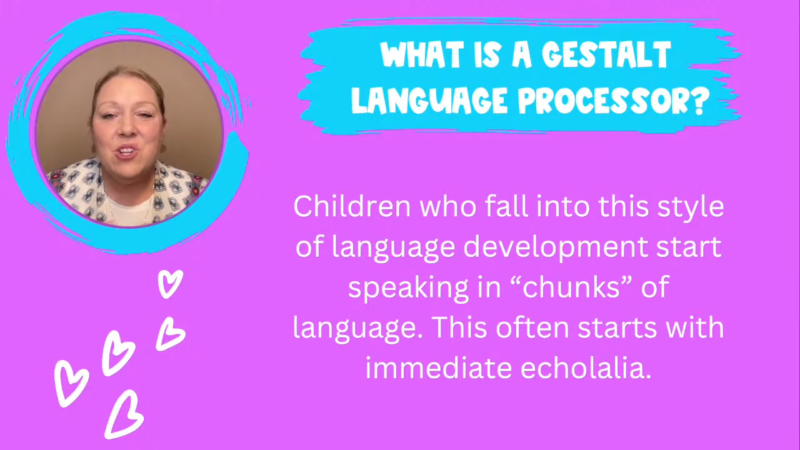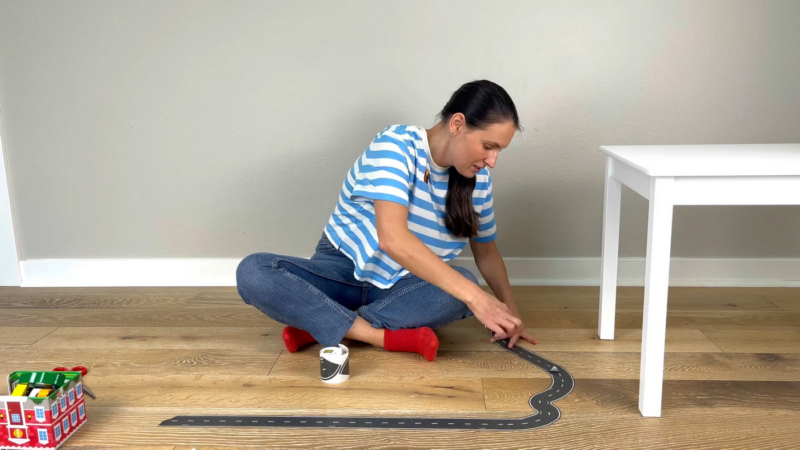Gestalt Language Processing (GLP) is a method of language development focusing on whole phrases rather than individual words. It begins with children imitating phrases they’ve heard, known as delayed echolalia, before they dissect these phrases into individual words. Understanding GLP is crucial for parents and educators to support children’s communication skills effectively.
Unlike traditional language development, GLP starts with large chunks of language, gradually breaking them down into smaller units. This approach can be especially prevalent in children with Autism Spectrum Disorder (ASD) but is also seen in typically developing children. By recognizing the signs of GLP, caregivers can tailor their approaches to foster more effective communication.
This article explores the characteristics of GLP, how it differs from analytic language processing, and the benefits and challenges associated with this method.
Characteristics

Gestalt Language Processing is characterized by the initial focus on whole phrases. Children often repeat phrases, such as “let’s go everybody,” without understanding the individual words. This phenomenon, known as delayed echolalia, is a core feature of GLP.
Later, Children begin to break down these phrases, learning the meaning of each word. They then use these individual words to construct new sentences. The progression from whole to part is a key difference from the analytic approach, where language learning starts to single words. This method is also very good for improving speech disorders, like CAS.
Dr. Barry Prizant, speech-language pathologist and author of Uniquely Human: A Different Way of Seeing Autism:
“Echolalia in Gestalt Language Processing can be a powerful tool for children with autism to communicate, serving as a bridge from imitation to spontaneous speech.”
Comparison of Analytic and Gestalt Language Processing
| Aspect | Analytic Language Processing | Gestalt Language Processing |
|---|---|---|
| Starting Point | Single words | Whole phrases |
| Language Development Path | Parts to whole | Whole to parts |
| Common in | Typical development | Often in ASD and typical development |
| Initial Communication | Word combinations | Echolalia (repeated phrases) |
| Progression | Gradual increase in complexity | Gradual breakdown of phrases |
Dr. Temple Grandin, Professor of Animal Science and advocate for people with autism: “Gestalt Language Processing in children can offer unique insights into how they perceive and interact with the world, highlighting the importance of seeing beyond the words to the intention behind them.”
Identifying Gestalt Language Processing
@empoweringspeechservices Are you looking for ideas to help your Gestalt Language Processor in Stages 4/5/6. Here are some ways you can model language with kinetic sand and tiny objects you can “hide” in the sand. Kids love to find the things you hide for them! They can hide them for you, too! It’s a great activity for sensory seekers. Stage 4: “This is a (toy name)”; “I found a ____”; “You are hiding it” Stage 5: “I found it all by myself!” “I want you to find them ”; “How do you hide it?” Stage 6: “She could be looking”; “Which toy do you want to hide?” “I know how to find it!” Source of grammar: DSS by Laura Lee (1974) #gestaltlanguageprocessor #gestaltlanguageprocessing #echolalia #autismandecholalia #naturallanguageacquisition #meaningfulspeech #empoweringspeechservices #speechtherapy #homebasedslp #gestaltlanguageprocessors #pediatricspeechtherapy #neurodiversity #parentcoaching #speechtherapyideas
To identify GLP, observe if the child uses echolalia, repeating phrases they have heard. For instance, a child might mimic “let’s go everybody” from a TV show without understanding each word.
Over time, the child begins to parse these phrases, understanding and using the words more effectively. Speech-language pathologists (SLPs) play a vital role in assessing these patterns and guiding appropriate interventions.
Marge Blanc, speech-language pathologist and author of Natural Language Acquisition on the Autism Spectrum: “Gestalt Language Processing is not just a hurdle to overcome but a legitimate pathway to language acquisition, requiring a supportive and understanding approach.”
Benefits and Challenges
Benefits:
- Enhanced Understanding: As children dissect memorized phrases, they gain a richer understanding of language, allowing more nuanced communication.
- Effective Communication: Understanding the child’s communication style helps tailor support strategies, facilitating better interaction.
Challenges:
- Transitioning from Echolalia: Moving from memorized phrases to spontaneous speech can be challenging, especially for children with ASD.
- Contextual Language Use: Children may struggle with adjusting language to different social contexts, leading to misunderstandings.
Dr. Stephen Camarata, Professor of Hearing and Speech Sciences at Vanderbilt University: “Understanding Gestalt Language Processing is crucial for appreciating the full spectrum of language development strategies, especially in children with unique neurological profiles.”
Supporting Children with Gestalt Language Processing
Support for children with GLP involves:
- Modeling Clear Language: Use simple, clear language to aid understanding.
- Visual Aids: Visual supports help break down phrases into understandable parts.
- Encouraging AAC: Augmentative and Alternative Communication devices can assist in language development.
Michelle Garcia Winner, speech-language pathologist and founder of Social Thinking: “For some children, Gestalt Language Processing isn’t merely about repetition; it’s about building a library of meaningful scripts that they can access and adapt as they develop.”
Conclusion
Gestalt Language Processing provides a distinct approach to language development, emphasizing the significance of whole phrases before breaking them down into individual components. Understanding GLP is essential for parents, educators, and therapists to offer appropriate support tailored to each child’s needs. By recognizing the characteristics and challenges associated with GLP, caregivers can foster more effective communication.
This approach not only enhances communication skills but also provides a deeper understanding of each child’s unique interaction style. Embracing and supporting GLP helps children reach their full communicative potential, enriching their experiences and interactions.

